A Comparative Analysis of Characteristics and Synoptic Backgrounds of Extreme Heat Events over Two Urban Agglomerations in Southeast China
Abstract
1. Introduction
2. Data and Methods
2.1. Data
2.2. Definition and Analysis of EHEs
3. Characteristics of EHEs over the Two Regions
3.1. Spatial Distribution of EHEs
3.2. Temporal Variation of the Regional Heatwaves
4. Synoptic Backgrounds for the Mid-Summer YRD- and PRD-Regional Heatwaves
4.1. The YRD-Only Heatwaves
4.2. The PRD-Only Heatwaves
4.3. The YRD and PRD Simultaneous Heatwaves
5. Summary and Conclusions
Author Contributions
Funding
Data Availability Statement
Conflicts of Interest
References
- Mora, C.; Dousset, B.; Caldwell, I.R.; Powell, F.E.; Geronimo, R.C.; Bielecki, C.R.; Counsell, C.W.; Dietrich, B.S.; Johnston, E.T.; Louis, L.V.; et al. Global risk of deadly heat. Nat. Clim. Chang. 2017, 7, 501–507. [Google Scholar] [CrossRef]
- Miller, S.; Muir-Wood, R.; Boissonnade, A. An exploration of trends in normalized weather-related catastrophe losses. In Climate Extremes and Society; Diaz, H., Murnane, R., Eds.; Cambridge University Press: Cambridge, UK, 2008; pp. 225–247. [Google Scholar]
- Karoly, D.J. The recent bushfires and extreme heatwave in southeast Australia. Bull. Aust. Meteorol. Oceanogr. Soc. 2009, 22, 10–13. [Google Scholar]
- Christidis, N.; Jones, G.S.; Stott, P.A. Dramatically increasing chance of extremely hot summers since the 2003 European heat wave. Nat. Clim. Chang. 2015, 5, 46–50. [Google Scholar] [CrossRef]
- IPCC AR6 Climate Change 2022: Impacts, Adaptation and Vulnerability. Available online: https://www.ipcc.ch/report/ar6/wg2/downloads/report/IPCC_AR6_WGII_FullReport.pdf (accessed on 7 November 2022).
- Perkins, S.E. A review on the scientific understanding of heatwaves-Their measurement, driving mechanisms, and changes at the global scale. Atmos. Res. 2015, 164, 242–267. [Google Scholar] [CrossRef]
- Kenyon, J.; Hegerl, G.C. Influence of modes of climate variability on global temperature extremes. J. Clim. 2008, 21, 3872–3889. [Google Scholar] [CrossRef]
- Cowan, T.; Hegerl, G.C.; Colfescu, I.; Bollasina, M.; Purich, A.; Boschat, G. Factors contributing to record-breaking heat waves over the Great Plains during the 1930s Dust Bowl. J. Clim. 2017, 30, 2437–2461. [Google Scholar] [CrossRef]
- Luo, M.; Lau, N. Heat waves in southern China: Synoptic behavior, long-term change, and urbanization effects. J. Clim. 2017, 30, 703–720. [Google Scholar] [CrossRef]
- Meehl, G.A.; Tebaldi, C. More intense, more frequent, and longer lasting heat waves in the 21st century. Science 2004, 305, 994–997. [Google Scholar] [CrossRef]
- Black, E.; Blackburn, M.; Harrison, G.; Hoskins, B.; Methven, J. Factors contributing to the summer 2003 European heatwave. Weather 2004, 59, 217–223. [Google Scholar] [CrossRef]
- Vautard, R.; Gobiet, A.; Jacob, D.; Belda, M.; Colette, A.; Déqué, M.; Fernández, J.; García-Díez, M.; Goergen, K.; Güttler, I.; et al. The simulation of European heat waves from an ensemble of regional climate models within the EURO-CORDEX project. Clim. Dyn. 2013, 41, 2555–2575. [Google Scholar] [CrossRef]
- Matsueda, M. Predictability of Euro-Russian blocking in summer of 2010. Geophys. Res. Lett. 2011, 38, L06801. [Google Scholar] [CrossRef]
- Chen, R.; Wen, Z.; Lu, R. Large-scale circulation anomalies and intraseasonal oscillations associated with long-lived extreme heat events in South China. J. Clim. 2018, 31, 213–232. [Google Scholar] [CrossRef]
- Marshall, A.G.; Hudson, D.; Wheeler, M.C.; Alves, O.; Hendon, H.H.; Pook, M.J.; Risbey, J.S. Intra-seasonal drivers of extreme heat over Australia in observations and POAMA-2. Clim. Dyn. 2014, 43, 1915–1937. [Google Scholar] [CrossRef]
- Chen, T.C.; Wang, S.Y.; Yen, M.C.; Clark, A.J.; Tsay, J.D. Sudden surface warming-drying events caused by typhoon passages across Taiwan. J. Appl. Meteorol. Clim. 2010, 49, 234–252. [Google Scholar] [CrossRef]
- Shibata, Y.; Kawamura, R.; Hatsushika, H. Role of large-scale circulation in Triggering Foehns in the Hokuriku District of Japan during Midsummer. J. Meteorol. Soc. Jpn. 2010, 88, 313–324. [Google Scholar] [CrossRef]
- Parker, T.J.; Berry, G.J.; Reeder, M.J. The influence of tropical cyclones on heat waves in Southeastern Australia. Geophys. Res. Lett. 2013, 40, 6264–6270. [Google Scholar] [CrossRef]
- Alexander, L. Extreme heat rooted in dry soils. Nat. Geosci. 2010, 4, 12–13. [Google Scholar] [CrossRef]
- Seneviratne, S.I.; Lüthi, D.; Litschi, M.; Schär, C. Land–atmosphere coupling and climate change in Europe. Nature 2006, 443, 205–209. [Google Scholar] [CrossRef]
- Lorenz, R.; Jaeger, E.B.; Seneviratne, S.I. Persistence of heat waves and its link to soil moisture memory. Geophys. Res. Lett. 2010, 37, L09703. [Google Scholar] [CrossRef]
- Oke, T.R.; Johnson, G.T.; Steyn, D.G.; Watson, I.D. Simulation of surface urban heat islands under ‘ideal’ conditions at night. Part 2: Diagnosis of causation. Bound Lay Meteorol. 1991, 56, 339–358. [Google Scholar] [CrossRef]
- Fischer, E.M.; Oleson, K.W.; Lawrence, D.M. Contrasting urban and rural heat stress responses to climate change. Geophys. Res. Lett. 2012, 39, 2011GL05057. [Google Scholar] [CrossRef]
- Zhao, S.; Zhou, D.; Zhu, C.; Qu, W.; Zhao, J.; Sun, Y.; Huang, D.; Wu, W.; Liu, S. Rates and patterns of urban expansion in China’s 32 major cities over the past three decades. Landsc. Ecol. 2015, 30, 1541–1559. [Google Scholar] [CrossRef]
- Liao, W.; Liu, X.; Li, D.; Luo, M.; Wang, D.; Wang, S.; Baldwin, J.; Lin, L.; Li, X.; Feng, K.; et al. Stronger contributions of urbanization to heat wave trends in wet climates. Geophys. Res. Lett. 2018, 45, 11310–11317. [Google Scholar] [CrossRef]
- Wu, K.; Yang, X. Urbanization and heterogeneous surface warming in eastern China. Chin. Sci. Bull. 2013, 58, 1363–1373. [Google Scholar] [CrossRef]
- Yang, X.; Ruby Leung, L.; Zhao, N.; Zhao, C.; Qian, Y.; Hu, K.; Liu, X.; Chen, B. Contribution of urbanization to the increase of extreme heat events in an urban agglomeration in east China. Geophys. Res. Lett. 2017, 44, 6940–6950. [Google Scholar] [CrossRef]
- Zhang, N.; Zhu, L.F.; Zhu, Y. Urban heat island and boundary layer structures under hot weather synoptic conditions: A case study of Suzhou city, China. Adv. Atmos. Sci. 2011, 28, 855–865. [Google Scholar] [CrossRef]
- Ding, T.; Qian, W.; Yan, Z. Changes in hot days and heat waves in China during 1961–2007. Int. J. Climatol. 2010, 30, 1452–1462. [Google Scholar] [CrossRef]
- Chen, R.; Lu, R. Large-scale circulation anomalies associated with ‘tropical night’ weather in Beijing, China. Int. J. Climatol. 2014, 34, 1980–1989. [Google Scholar] [CrossRef]
- Chen, R.; Wen, Z.; Lu, R.; Wang, C. Causes of the extreme hot midsummer in central and South China during 2017: Role of the western tropical pacific warming. Adv. Atmos. Sci. 2019, 36, 465–478. [Google Scholar] [CrossRef]
- Zhong, Z.; Chen, X.; Yang, X.Q.; Ha, Y.; Sun, Y. The relationship of frequent tropical cyclone activities over the western North Pacific and hot summer days in central-eastern China. Theor. Appl. Climatol. 2019, 138, 1395–1404. [Google Scholar] [CrossRef]
- Li, Y.; Ding, Y.; Liu, Y. Mechanisms for regional compound hot extremes in the mid-lower reaches of the Yangtze River. Int. J. Climatol. 2020, 41, 1292–1304. [Google Scholar] [CrossRef]
- Cao, L.; Zhu, Y.; Tang, G.; Yuan, F.; Yan, Z. Climatic warming in China according to a homogenized data set from 2419 stations. Int. J. Climatol. 2016, 36, 4384–4392. [Google Scholar] [CrossRef]
- Luo, M.; Lau, N. Amplifying effect of ENSO on heat waves in China. Clim. Dyn. 2019, 52, 3277–3289. [Google Scholar] [CrossRef]
- Yuan, X.; Wang, L.; Wu, P.; Ji, P.; Sheffield, J.; Zhang, M. Anthropogenic shift towards higher risk of flash drought over China. Nat. Commun. 2019, 10, 4661. [Google Scholar] [CrossRef] [PubMed]
- Ying, M.; Zhang, W.; Yu, H.; Lu, X.; Feng, J.; Fan, Y.; Zhu, Y.; Chen, D. An overview of the China Meteorological Administration tropical cyclone database. J. Atmos. Ocean. Technol. 2014, 31, 287–301. [Google Scholar] [CrossRef]
- Lu, X.; Yu, H.; Ying, M.; Zhao, B.; Zhang, S.; Lin, L.; Bai, L.; Wan, R. Western North Pacific tropical cyclone database created by the China Meteorological Administration. Adv. Atmos. Sci. 2021, 38, 690–699. [Google Scholar] [CrossRef]
- Wang, X.; Xiao, F.; Feng, X.; Li, X. Extraction of large-scale urban area information in China using DMSP/OLS nighttime light data. Remote Sens. Land Resour. 2013, 25, 159–164. [Google Scholar]
- Ward, R.D. The Climates of the United States; Ginn: Oxford, UK, 1925; pp. 383–395. [Google Scholar]
- Schoetter, R.; Cattiaux, J.; Douville, H. Changes of western European heat wave characteristics projected by the CMIP5 ensemble. Clim. Dyn. 2015, 45, 1601–1616. [Google Scholar] [CrossRef]
- Fischer, E.M.; Schär, C. Consistent geographical patterns of changes in high-impact European heatwaves. Nat. Geosci. 2010, 3, 398–403. [Google Scholar] [CrossRef]
- Chen, Y.; Zhai, P. Revisiting summertime hot extremes in China during 1961–2015: Overlooked compound extremes and sig-nificant changes. Geophys. Res. Lett. 2017, 44, 5096–5103. [Google Scholar] [CrossRef]
- Gao, H.; Luo, Y.; Jiang, X.; Zhang, D.L.; Chen, Y.; Wang, Y.; Shen, X. A statistical analysis of extreme hot characteristics and their relationships with urbanization in southern China during 1971–2020. J. Appl. Meteorol. Clim. 2021, 60, 1301–1317. [Google Scholar] [CrossRef]
- Oke, T.R. The energetic basis of the urban heat island. Quart. J. Roy. Meteor. Soc. 1982, 108, 1–24. [Google Scholar] [CrossRef]
- Ding, Y. Monsoons over China; Kluwer Academic Publishers: Dordrecht, The Netherlands; Boston, MA, USA; London, UK, 1994; p. 419. [Google Scholar]
- Gaffin, D.M. Foehn winds that produced large temperature differences near the southern Appalachian Mountains. Weather Forecast. 2007, 22, 145–159. [Google Scholar] [CrossRef]
- Zhao, D.; Lin, Y.; Li, Y.; Gao, X. An extreme heat event induced by Typhoon Lekima (2019) and its contributing factors. J. Geophys. Res. Atmos. 2021, 126, e2021JD034760. [Google Scholar] [CrossRef]
- Knutson, T.R.; McBride, J.L.; Chan, J.; Emanuel, K.; Holland, G.; Landsea, C.; Held, I.; Kossin, J.P.; Srivastava, A.K.; Sugi, M. Tropical cyclones and climate change. Nat. Geosci. 2016, 3, 157–163. [Google Scholar] [CrossRef]
- Walsh, K.J.E.; McBride, J.L.; Klotzbach, P.J.; Balachandran, S.; Camargo, S.J.; Holland, G.; Knutson, T.R.; Kossin, J.P.; Lee, T.C.; Sobel, A.; et al. Tropical cyclones and climate change. Wires. Clim. Chang. 2016, 7, 65–89. [Google Scholar] [CrossRef]
- Matthews, T.; Wilby, R.L.; Murphy, C. An emerging tropical cyclone-deadly heat compound hazard. Nat. Clim. Chang. 2019, 9, 602–606. [Google Scholar] [CrossRef]
- Provencal, S.; Bergeron, O.; Leduc, R.; Barrette, N. Thermal comfort in Quebec City, Canada: Sensitivity analysis of the UTCI and other popular thermal comfort indices in a mid-latitude continental city. Int. J. Biometeorol. 2016, 60, 591–603. [Google Scholar] [CrossRef] [PubMed]
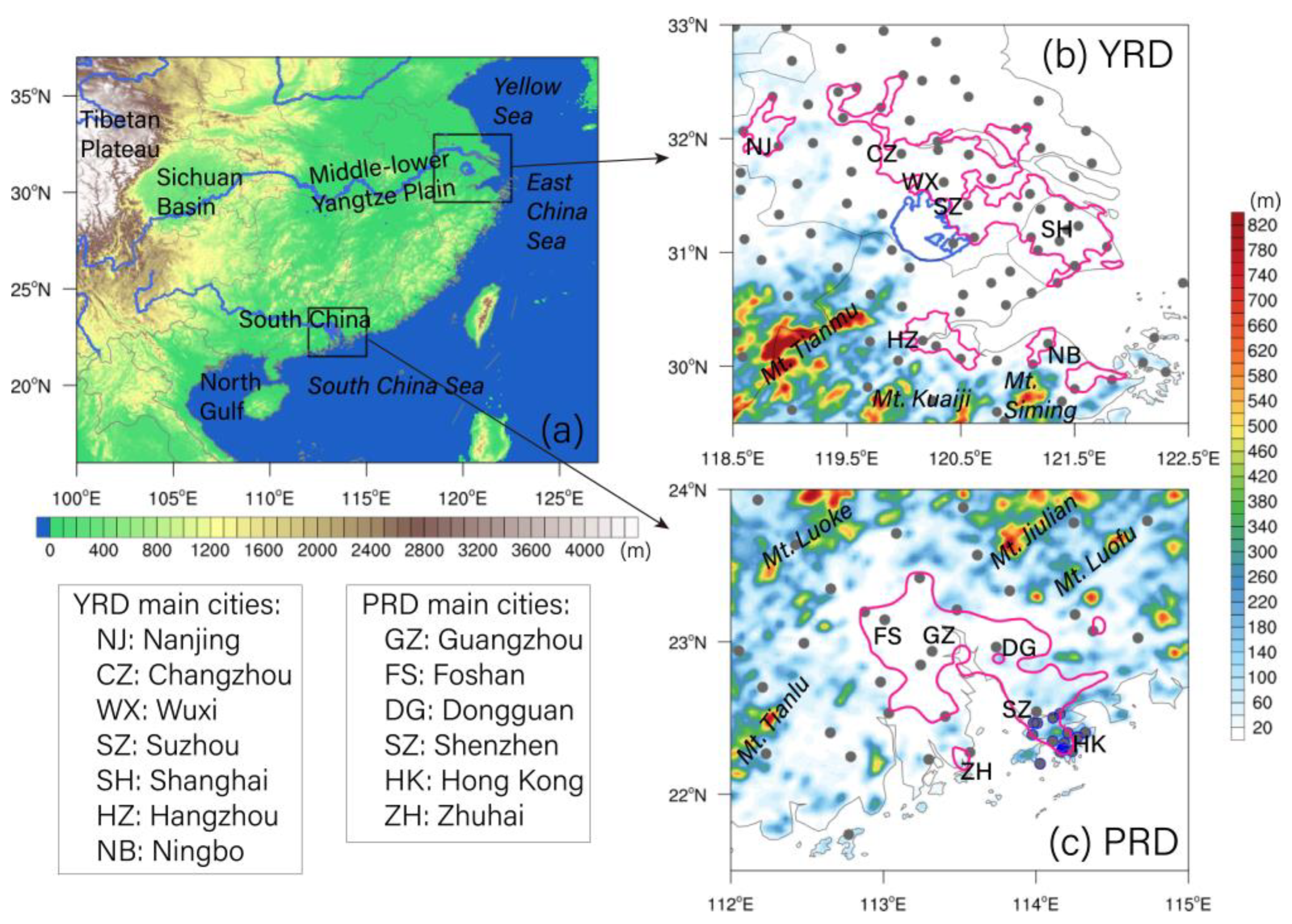
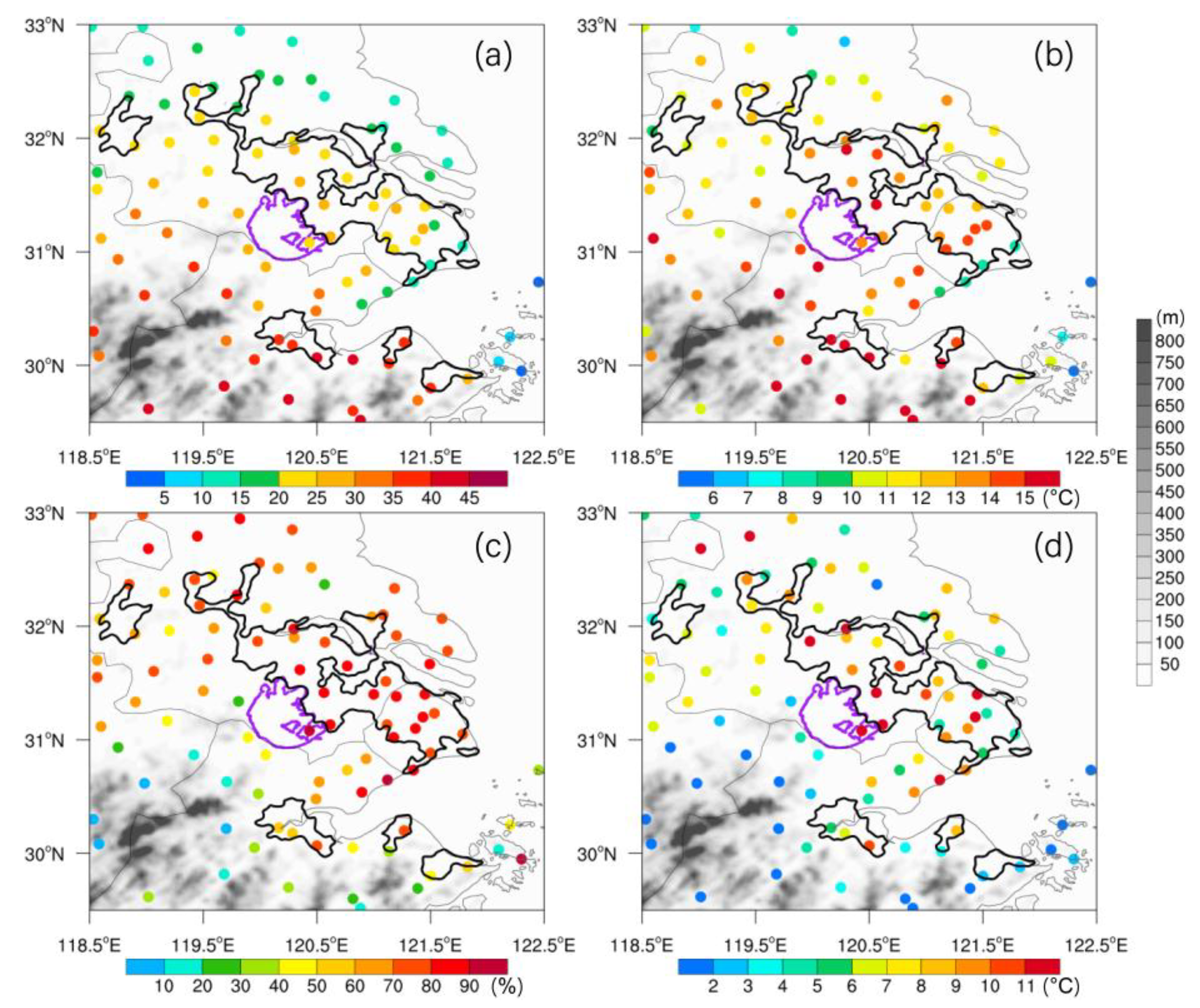

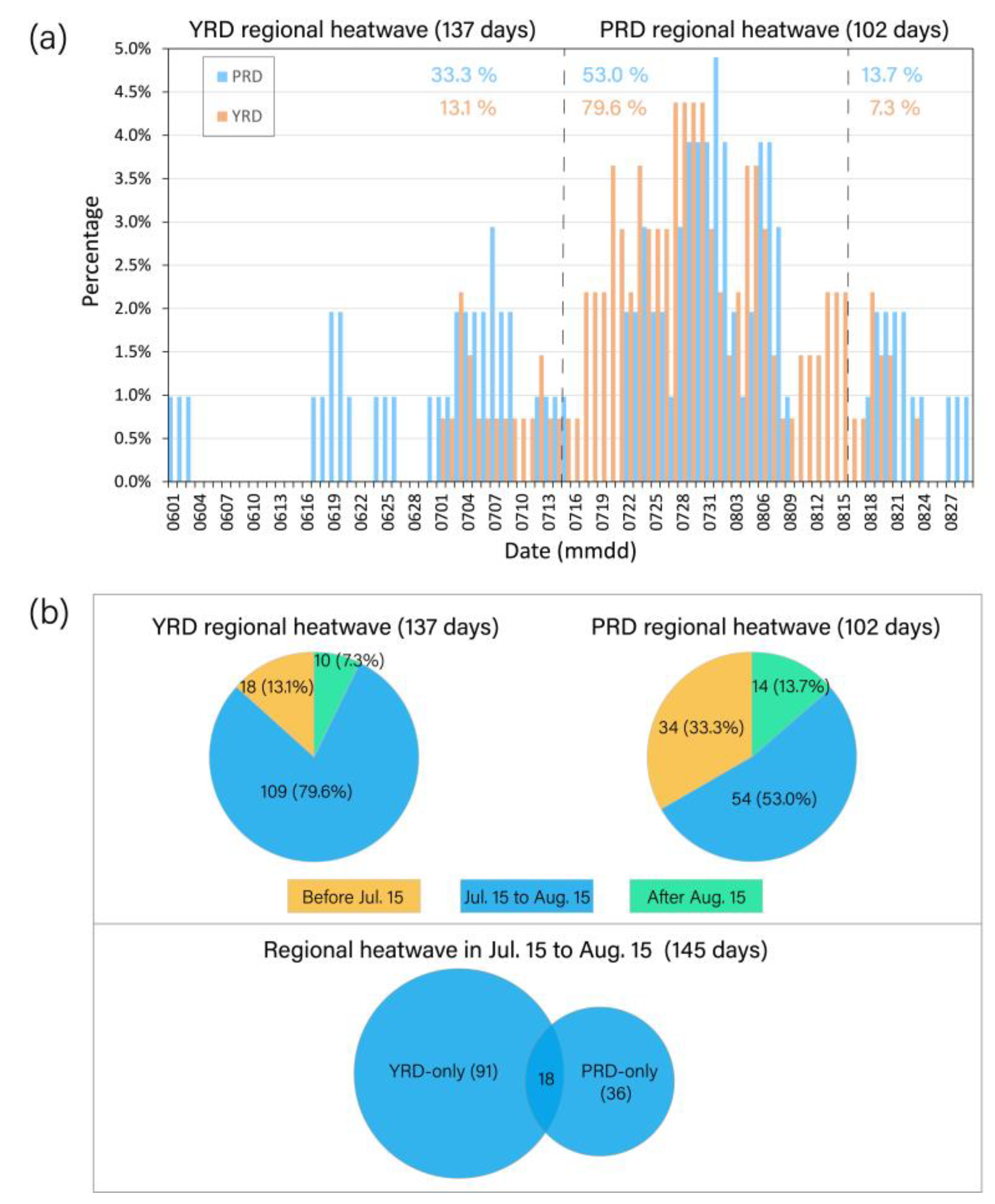
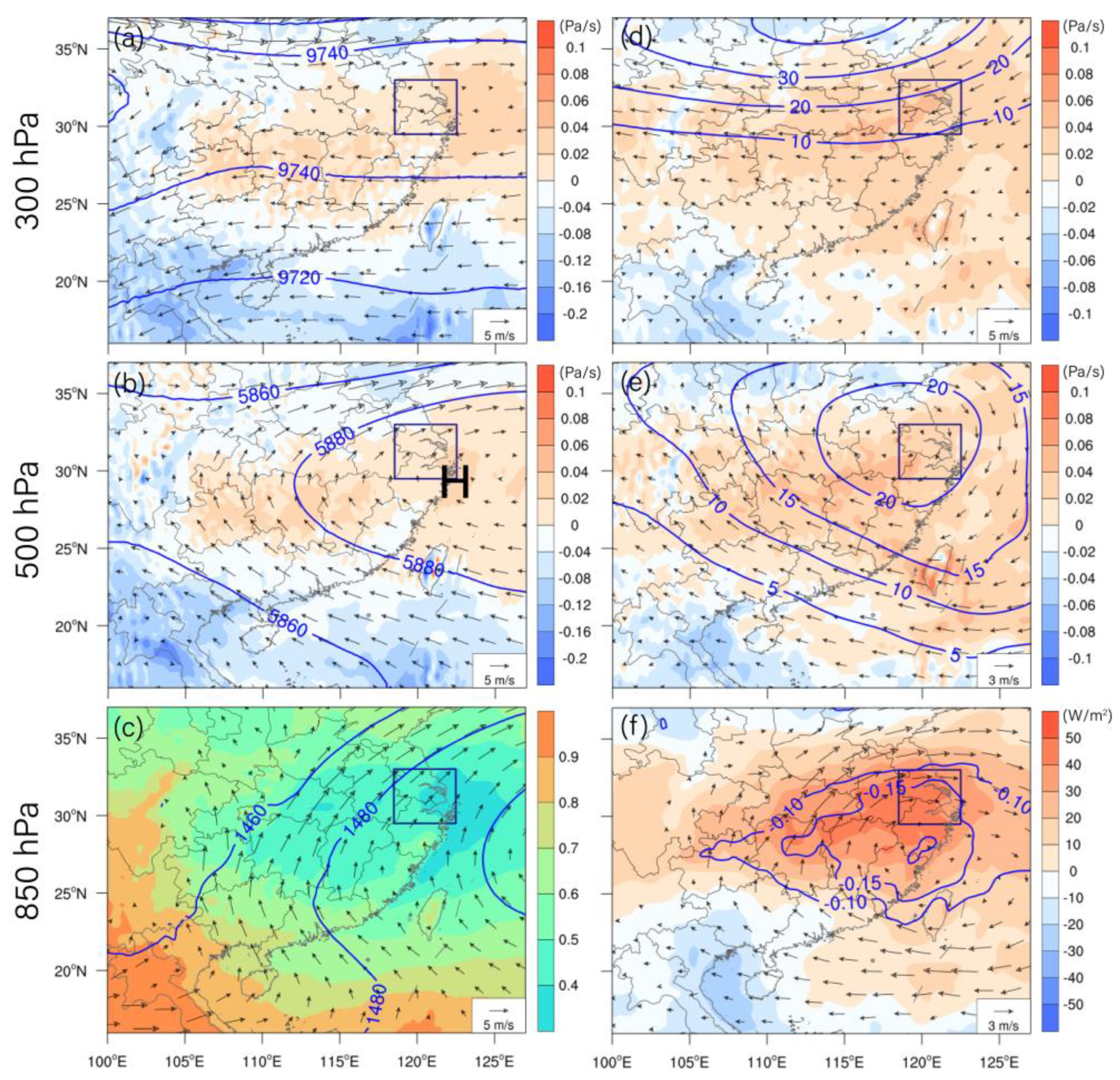
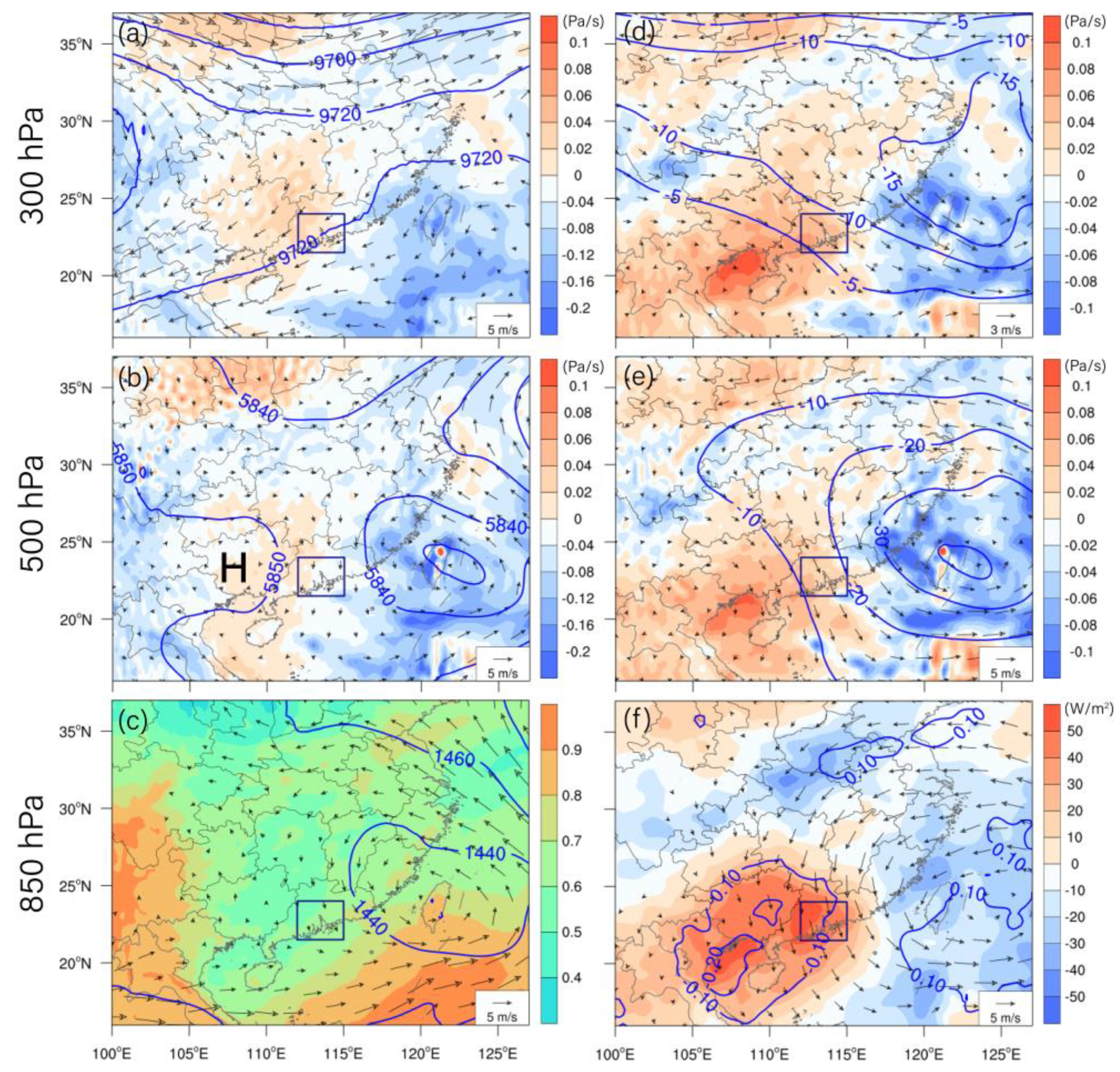
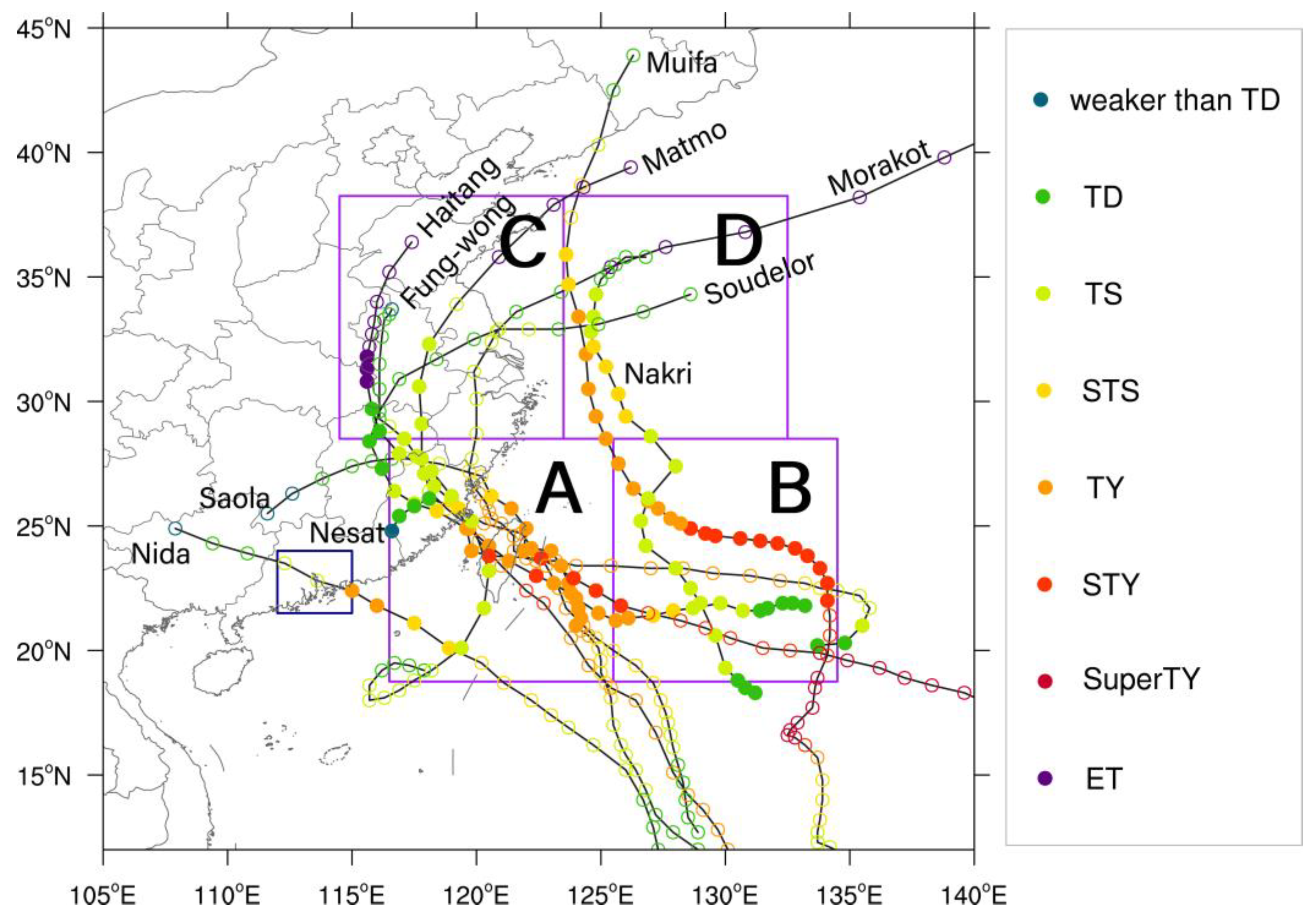
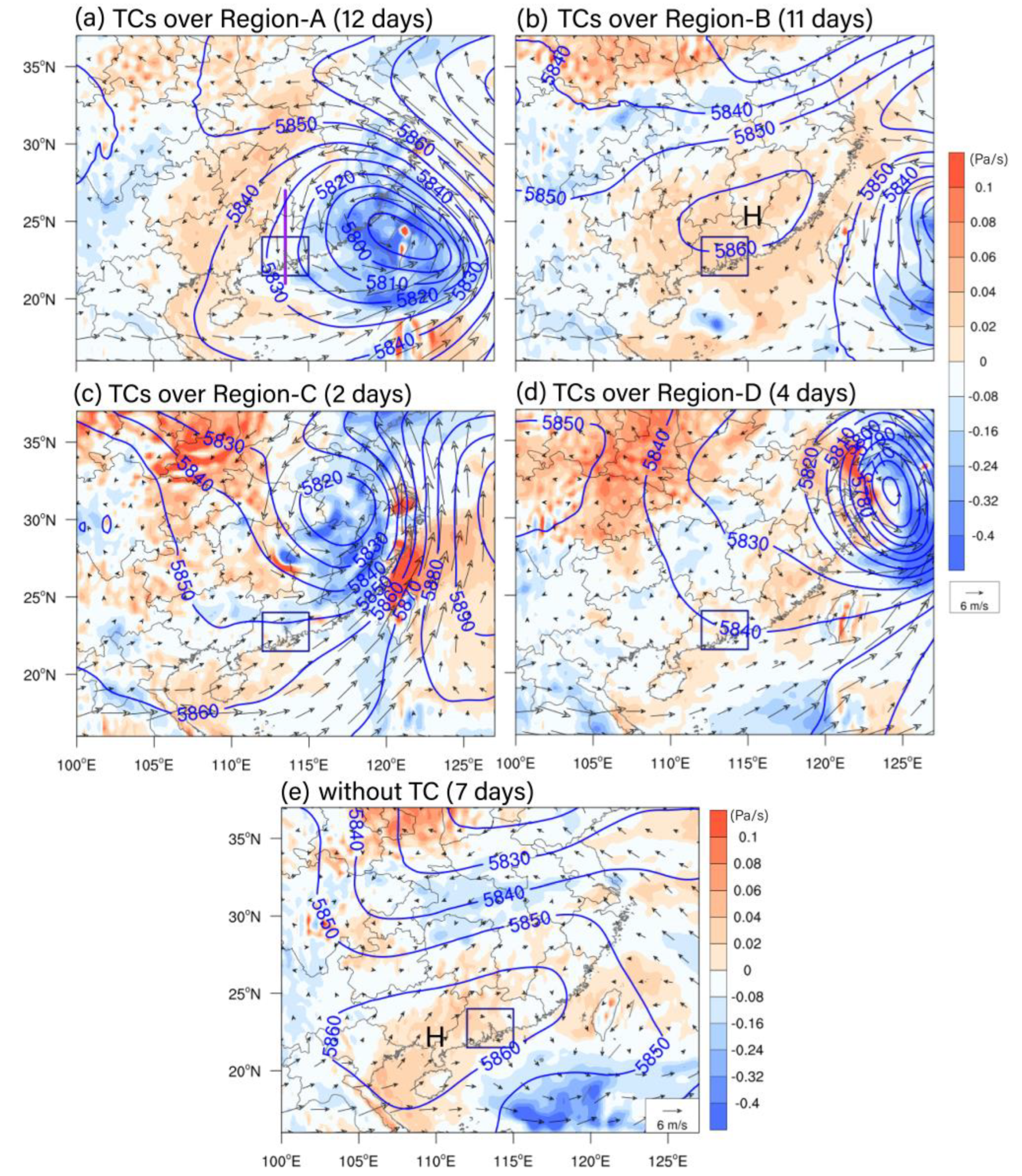
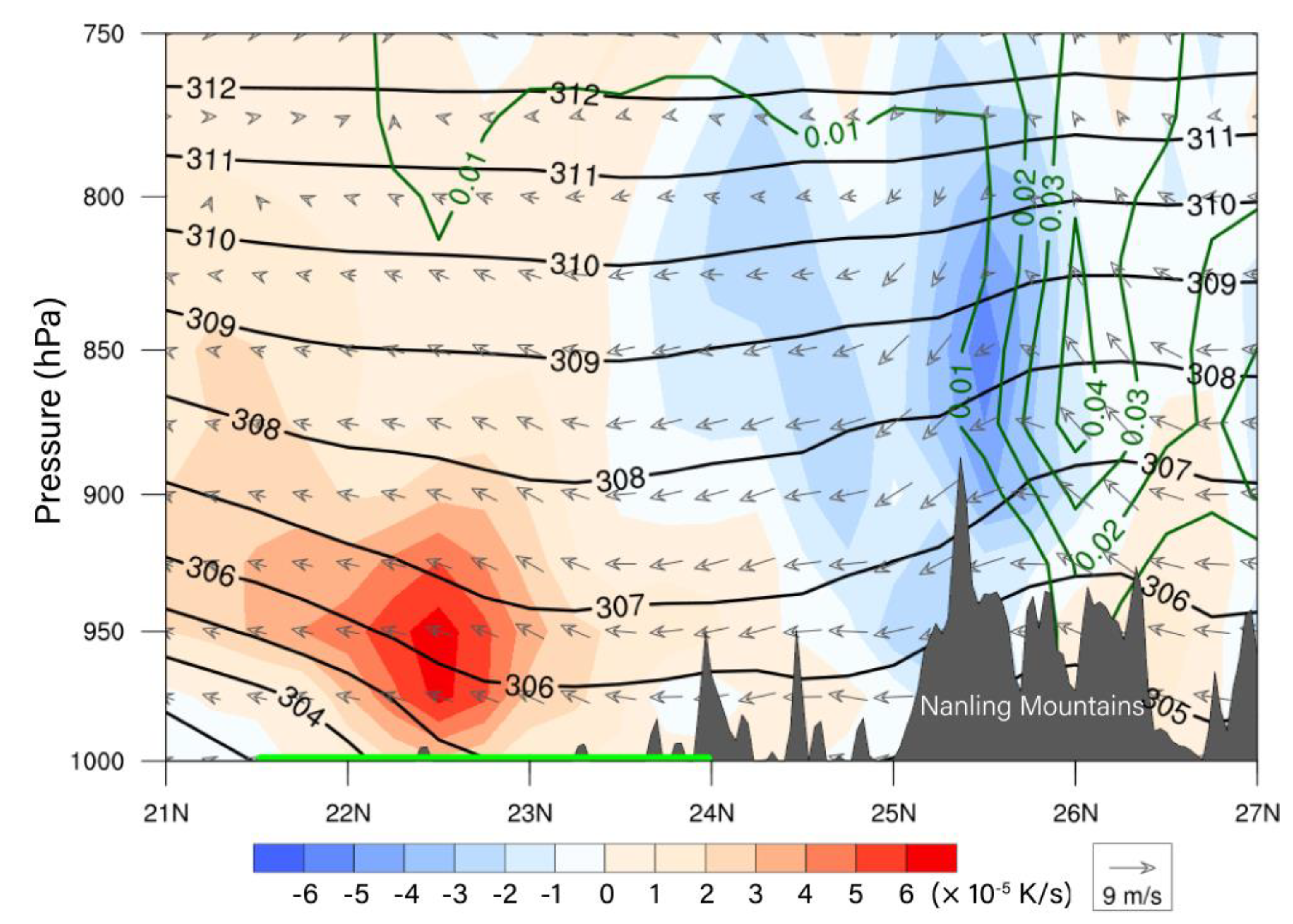
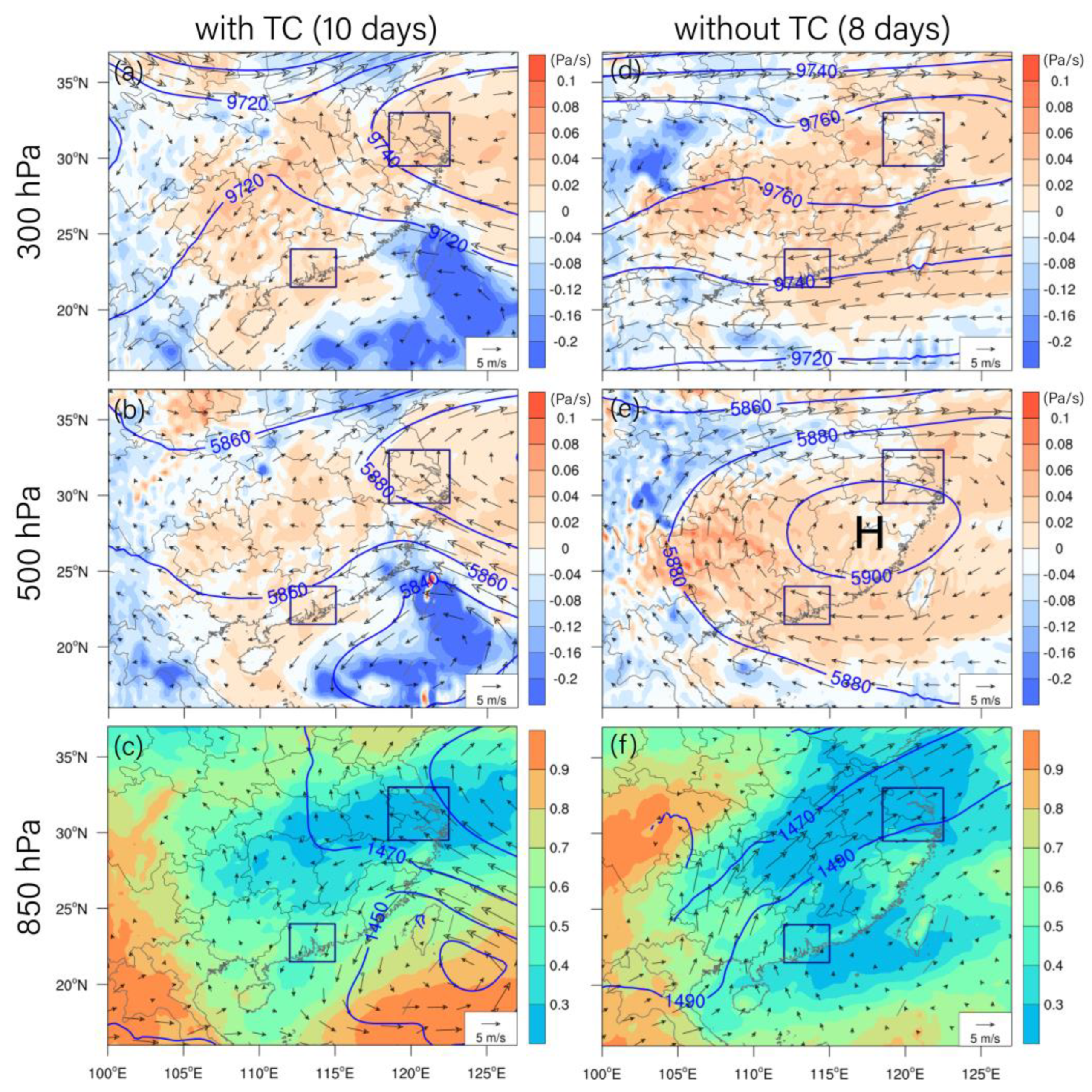
| TC Number | TC’s Name | TC’s Life Span (mmddhh UTC) |
|---|---|---|
| 0808 | Fung-wong | 072400-073118 |
| 0908 | Morakot | 080306-081306 |
| 1109 | Muifa | 072700-080900 |
| 1209 | Saola | 072618-080500 |
| 1410 | Matmo | 071700-072600 |
| 1412 | Nakri | 072900-080400 |
| 1513 | Soudelor | 073000-081206 |
| 1604 | Nida | 072912-080300 |
| 1709 | Nesat | 072500-073100 |
| 1710 | Haitang | 072712-080306 |
Publisher’s Note: MDPI stays neutral with regard to jurisdictional claims in published maps and institutional affiliations. |
© 2022 by the authors. Licensee MDPI, Basel, Switzerland. This article is an open access article distributed under the terms and conditions of the Creative Commons Attribution (CC BY) license (https://creativecommons.org/licenses/by/4.0/).
Share and Cite
Sun, X.; Gao, X.; Luo, Y.; Wong, W.-K.; Xu, H. A Comparative Analysis of Characteristics and Synoptic Backgrounds of Extreme Heat Events over Two Urban Agglomerations in Southeast China. Land 2022, 11, 2235. https://doi.org/10.3390/land11122235
Sun X, Gao X, Luo Y, Wong W-K, Xu H. A Comparative Analysis of Characteristics and Synoptic Backgrounds of Extreme Heat Events over Two Urban Agglomerations in Southeast China. Land. 2022; 11(12):2235. https://doi.org/10.3390/land11122235
Chicago/Turabian StyleSun, Xiaoyan, Xiaoyu Gao, Yali Luo, Wai-Kin Wong, and Haiming Xu. 2022. "A Comparative Analysis of Characteristics and Synoptic Backgrounds of Extreme Heat Events over Two Urban Agglomerations in Southeast China" Land 11, no. 12: 2235. https://doi.org/10.3390/land11122235
APA StyleSun, X., Gao, X., Luo, Y., Wong, W.-K., & Xu, H. (2022). A Comparative Analysis of Characteristics and Synoptic Backgrounds of Extreme Heat Events over Two Urban Agglomerations in Southeast China. Land, 11(12), 2235. https://doi.org/10.3390/land11122235







